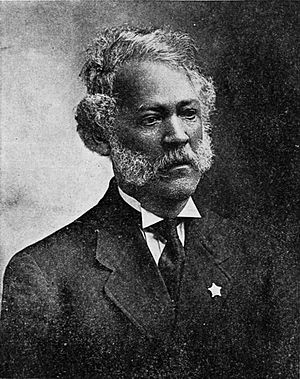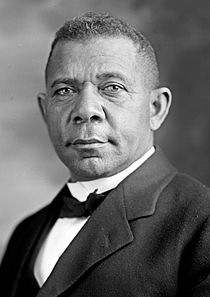William H. Davis (educator) facts for kids
Quick facts for kids
William H. Davis
|
|
|---|---|

Portrait of Davis, published in The Institute Monthly in 1911
|
|
| Born | November 27, 1848 Columbus, Ohio, U.S.
|
| Died | March 24, 1938 (aged 89) |
| Burial place | Spring Hill Cemetery, Charleston, West Virginia, U.S. |
| Occupation | Educator and school administrator |
| Spouse(s) | Hallie Ann Lewis |
| Children | 4 |
| Military career | |
| Allegiance | |
| Years of service | 1863–1865 |
| Rank | Private |
| Unit | 7th Independent Company (Union Light Guard), Ohio Volunteer Cavalry |
| Scientific career | |
| Institutions | African-American schools in Tinkersville, West Virginia and Charleston, West Virginia |
| Notable students | |
William H. Davis (November 27, 1848 – March 24, 1938) was an important American educator and school leader in West Virginia. He is known for being the first teacher of the famous Booker T. Washington. Davis also made history as the first and only African-American person to run for governor of West Virginia, which he did in 1888.
Born in Columbus, Ohio, in 1848, Davis went to public schools there and in Chillicothe. After finishing school, he joined the Union Army during the American Civil War. His unit, the Union Light Guard, protected President Abraham Lincoln in Washington, D.C.. He was honorably discharged in 1865 due to a health issue.
After the war, Davis worked on a steamboat for a short time. In 1865, he became a schoolteacher in Tinkersville, where he taught former slaves. He later became the principal of African-American schools in Charleston in 1871. Davis taught for 47 years before retiring in 1913.
In 1888, Davis was chosen by the Colored Independent Party to run for governor. This party wanted to end school segregation and felt the Republican Party wasn't supporting African-American voters enough. Davis's campaign was a big step for African Americans in West Virginia politics.
Contents
Early Life and School Days
William H. Davis was born in Columbus, Ohio, on November 27, 1848. His family was very active in the Underground Railroad. This was a secret network that helped slaves escape from the Southern United States to freedom. They gave shelter and food to those seeking freedom.
Davis grew up in Columbus and went to public schools there. When he was 13, he moved to Chillicothe from 1861 to 1863. There, he continued his studies in English education. He returned to Columbus in the fall of 1863.
Serving in the Military
During the American Civil War, Davis joined the Union Army. He enlisted on December 18, 1863, in Columbus. His unit was called the 7th Independent Company of the Ohio Volunteer Cavalry. It was also known as the Union Light Guard.
This cavalry group had a special job: they guarded President Abraham Lincoln. They were often called the "President's Escort" or "Lincoln's Body Guard." They were stationed in Washington, D.C., protecting the White House and other government buildings.
Davis served as a private and worked as an assistant cook. He was in the Union Army for 18 months. He had to leave after getting a serious infection in his head. Doctors performed surgery, and he was honorably discharged on June 24, 1865. This was a few months after the war ended. Davis suffered from pain and hearing loss in one ear for the rest of his life because of this infection.
After leaving the army, Davis went back to Columbus to work with his father. Then he moved to Cincinnati. He got a job operating a steamboat that traveled between Gallipolis, Charleston, and Brownstown (now Marmet). In September 1865, he moved to Tinkersville, near Charleston.
A Career in Education

When Davis arrived in Tinkersville in 1865, many African Americans lived there. Most were former slaves who had worked in the local salt industry. People in town soon learned that Davis could read and write. Reverend Lewis Rice offered him a job teaching former slaves.
Davis, at 18 years old, became a teacher at Rice's private Tinkersville school. This was one of the first African-American schools in Kanawha County. It was also the first school in the Kanawha River valley led by an African-American teacher. The school was supported by the poor residents of Malden and first held classes in Rice's home. Later, it moved to a church and then to its own building.
Booker T. Washington and his family arrived in Malden about a month before Davis. Washington became one of Davis's students at the Tinkersville school. Davis was Washington's very first teacher. He even visited Washington's home to tutor him outside of school hours. Davis saw that Washington was a bright student who learned quickly and was well-liked by his classmates. Washington's wife, Fannie Smith Washington, also attended the Tinkersville school.
Davis sent the school's first report to the Freedmen's Bureau in November 1867. He noted that the school was supported by both the local school board and African-American residents. He was the only teacher. By January 1868, almost all his students were "advanced readers." After getting married in 1869, Davis moved to Charleston but continued to teach at Tinkersville. He walked six miles to and from school each day.
Davis's teaching skills became well-known. In 1871, he was hired as principal of Charleston's African-American schools. These schools started in a two-room building with about 100 students. Soon, the building expanded to four rooms. In 1872, the Kanawha County Schools superintendent praised Davis. He said Davis was "well qualified in every way" and gave him a top teaching certificate.
Davis led Charleston's African-American schools for 31 years. He was principal for 24 years, teaching in the city for a total of 47 years. When he left as principal, the school had grown to five rooms. It also had a grade system and improved teaching methods. He retired from the Charleston schools in 1913. Many African Americans in Charleston were either taught by Davis or were supervised by him. Davis also served on the Kanawha County Board of Examiners.
Davis and other teachers helped push for a state college for African Americans in Southern West Virginia. This led to the creation of the West Virginia Colored Institute (now West Virginia State University).
Running for Governor
In September 1888, 49 African-American leaders met in Charleston. They formed the Colored Independent Party. This party chose William H. Davis as their candidate for West Virginia governor. He was the main candidate on their state ticket.
The party was against the Republican Party. They felt the Republicans did not give African-American citizens the respect they deserved. The Colored Independent Party also spoke out against school segregation. They were also against large companies that had too much power.
Davis's campaign in the 1888 West Virginia gubernatorial election was very important. It was the first time African-American voters showed their political strength in a major state election. Davis became the first African American ever nominated to run for governor in West Virginia. To this day, he remains the only African-American candidate for governor in the state's history.
Family Life
In 1869, Davis married Hallie Ann Lewis in Tinkersville. They had four daughters: Mamie, Josephine, Inez, and Fannie. When he passed away in 1938, Davis had a large family. He had 17 grandchildren, 12 great-grandchildren, and 6 great-great-grandchildren.
Davis was a religious man. He joined the African Zion Baptist Church in Malden in 1866. In 1872, he became a member of the First Baptist Church in Charleston. For many years, he served as the financial and recording secretary for the First Baptist Church. Davis was also a member of several community groups. These included the Free and Accepted Masons, the Blundon post of the Grand Army of the Republic (GAR), and the Business and Professional Men's Club.
Later Years and Passing
In June 1911, Davis attended the West Virginia Colored Institute graduation. He presented an award and $15 in gold to a student named Jesse Fields. This award was for having the best grades in agriculture.
After Booker T. Washington died, Davis wrote a poem in 1916. It was called "Battle Hymn of the Negro" and honored Washington's memory. The poem was set to the music of Julia Ward Howe's "Battle Hymn of the Republic." In 1937, Tuskegee University held a celebration for Booker T. Washington. Davis was invited as a special guest of honor. Washington himself later said that Davis's teaching and dedication helped shape him into the person he became.
In November 1929, Davis was the commander of a GAR post. He had a disagreement with the state archivist about a historic U.S. flag. Davis believed the flag, which belonged to his GAR post, should be returned to them. However, the state archivist refused to give it back. In June 1931, Davis took part in a GAR meeting in Huntington. In November 1937, he marched with other Civil War veterans in Charleston's Armistice Day celebration.
William H. Davis died from pneumonia at his home in Charleston on March 24, 1938. He had lived in that home for 69 years. His funeral was held at Charleston's First Baptist Church on March 27, 1938. He was buried at Spring Hill Cemetery in Charleston. Davis was one of only two remaining GAR members in the Charleston area when he died. He was buried wearing his Union Army uniform. He was very proud of his uniform and the medals he received for serving in the Union Army.
Legacy and Recognition
A 1937 newspaper article about Davis said that Charleston's African-American citizens and the memory of Booker T. Washington would honor Davis's life work. His work helped educate and uplift African-American people. In 2011, one of Davis's descendants asked Charleston mayor Danny Jones to recognize Davis as an important local historical figure.
Davis has a highway historical marker in West Virginia. This marker is part of a program managed by West Virginia Archives and History. The marker's words say: "Born in Ohio in 1848, Davis served during the Civil War in the Union Light Guard of Ohio that was tasked with protecting President Lincoln. After the war, he moved to present-day Malden and later Charleston, where he served as an educator. His most noted student was Booker T. Washington. He became the first African-American candidate to run for governor in 1888. Died in 1938." You can find this marker on Kanawha Boulevard West, near the Mary C. Snow West Side Elementary School in Charleston.

